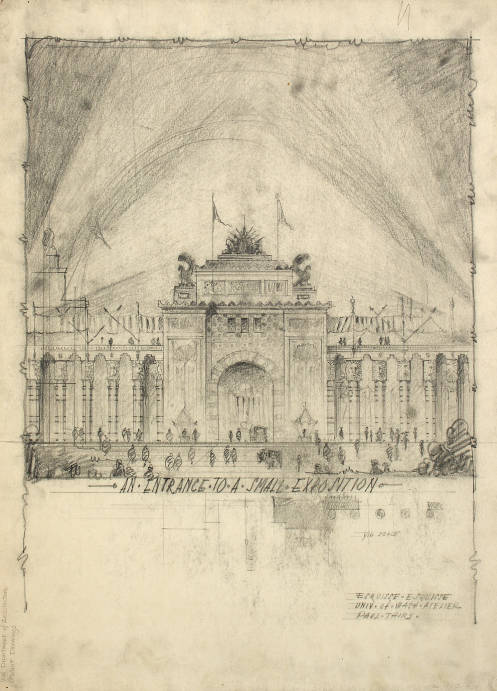
Sketch problem: esquisse-esquisse, graphite on mat board.
Entrance to a Small Exposition, ca. 1926-28.

Sketch problem: esquisse-esquisse, graphite on mat board.
Digital Collection item #ARC0900; URL: http://content.lib.washington.edu/u?/ac,1852
Paul Thiry (1904–1993) is known as the father of modernism in the Pacific Northwest and designed many distinctive period buildings around the state of Washington during the 1950s, '60s and '70s. Thiry earned a B.Arch from the University of Washington in 1928. He also studied at the Ecole des Beaux Arts France in 1927 and met Le Courbusier. He opened his own Seattle practice in 1929. During the Depression, Thiry took a yearlong trip to Europe, Asia, and Central America, where he was introduced to the work of the European Modernists.
Upon his return to Seattle, Thiry designed his own house (1936), but had few commissions in the 1930s. Those he built utilized a clear understanding of the European International Style in his use of spare, geometric forms, clean lines, and new building technologies." Thiry designed a cement-based stuccoed residence for Frank J. Bennett, a manager at Portland Cement. The house was featured in a 1940 issue of The Modern House in America.
Thiry later partnered with several Seattle architects, first as Jones, Thiry and Ahlson (1942); then as J Ones, Bouillon, Thiry & Sylliaasen, (1943-4). Notable projects include collaboration on the Holly Park Complex (1943); his own office at 600 Columbia Street (1946), the Museum of History and Industry (1952), and the Frye Museum (1952). Thiry was significantly involved in the Seattle Planning Commission from 1952-61.
Notable projects from this period include the Washington State Library, Olympia, (1959); Allison Wanamaker House, (1957); and the Christ Episcopal Church in Tacoma, (1962). Thiry was appointed the principal architect and head of the Design Committee of the Century 21 Seattle World's Fair. (1957-62) Thiry designed the Watzek Library (1968) and Agnes Flanagan Chapel (1969) and at Lewis and Clark College in Portland, OR. Thiry is quoted as having said that "buildings should be good neighbors."